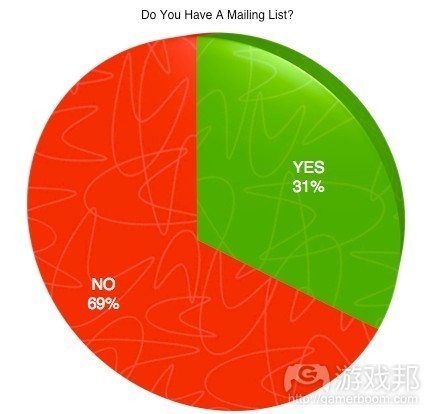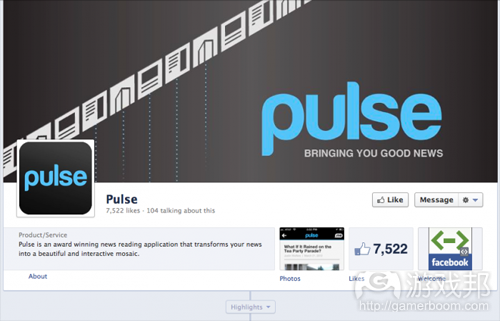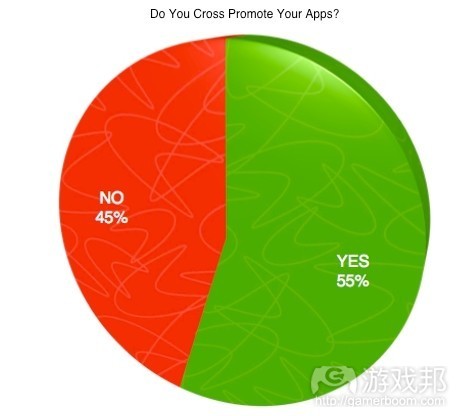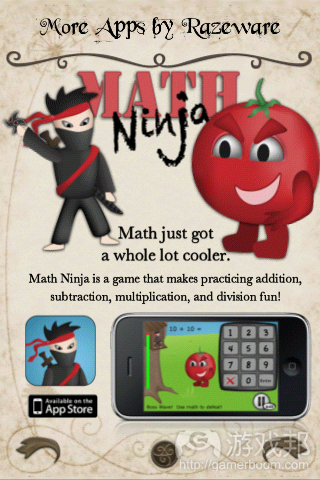【转】iOS游戏/应用的营销及推广技巧(3)
作者:Felipe Laso
在本系列的第1部分中,我们分享了你可以在预开发和开发阶段采取的措施,确保应用开发走上正确的轨道,增加应用成功的可能性。
在本系列的第2部分中,我们向你提供了许多应用发布的技巧,从决定发布日期到向媒体出版物发送发布通告等。(请点击此处阅读本文第4部分)
但是在应用发布数个月之后,情况如何呢?应用是否已经死亡?你是否应当将注意转向新的项目?
恰当的推广和对应用的关注能够让其获得更长的盈利时间!
在本系列第3部分中,我们将专注于探讨你能够用来保持用户对应用的兴趣并激发应用销量的做法。
1、更新应用
保持应用兴趣度的最简单战略是更新应用!至于更新为何是个不错的想法,有如下原因:
(1)用户期望你这么做。现在,用户期望你的应用能够定期更新,修正漏洞和添加新功能等。如果你不发布更新,用户可能就不会满意或者对应用的评价不佳。
(2)潜在的曝光度。当iOS发布主要新功能(游戏邦注:比如Retina Display或iCloud)时,如果你能够迅速跟进,在应用中添加相关的新功能,或许可以获得免费曝光的良好契机。博客往往会以利用新技术的应用为例来吸引读者,苹果也更有可能推荐利用新技术和设备功能的应用。
(3)可能增加销售量。发布更新可能增加销售量,因为用户在下载更新时会收到你的应用提醒,而且长期更新能够提升应用的质量和性能。
当然,更新应用需要付出时间和精力。现在,苹果并没有提供应用更新收费的方法,所以通过更新来盈利比制作新应用要困难。许多人都在讨论更新和制作新应用的取舍问题。
使用这种方法的最佳对象是非游戏应用,商店中销售情况较好的此类应用在功能和潜在用户上往往有大量成长的空间。
2、有效使用邮件列表
正如在第1部分中提到的那样,邮件列表是营销中性价比最高和最强大的技巧。如果用户喜欢产品,许多人都会主动注册自己的邮箱,跟踪将来可能出现的类似产品。
在我们的调查回应者中,将近1/3的人在他们的应用或公司中使用邮件列表:
“我让人们了解应用中的邮件列表,我向他们提供免费的电子书作为报答。电子书上的内容是我数年前在博客上撰写的材料,所以这方面不会花费我很多时间,而且这种方法确实很有用。因此,给人们注册邮件列表的理由。”——Matthijs Hollemans
我们在本部分文章中提及邮件列表的原因在于,如果使用得当,拥有订阅者是另一种扩展应用寿命的绝妙工具。
我能够确定,肯定有人在网上购买过东西,使用的可能是亚马逊、Ebay、Victoria’s Secret、GameStop、百思买和苹果等商店。
当你创建账户时,是否注意到那个询问你是否想要接收产品和打折相关新闻和信息的选框?勾选这个选框对你来说会很难吗?最多只需要数秒时间!
但是想想,你这个小小的动作就能够让你知道新闻和打折信息!
Code School的员工们总是会告诉我打折信息、新产品甚至发送我能够用来换取打折的推广码。亚马逊不时会发送我可能感兴趣的打折商品。
多数时间我都会忽略这些邮件,但有时我会看到自己很想要的东西或者我打算更换的东西。这对商家来说意味着什么呢?更大的销售量。
现在,将这种方法运用到你的产品中。你的用户要如何知道你正在开展圣诞促销?要如何知道你在iTunes上发布的最新应用?要如何知道你的应用在更新中添加了绝妙的新功能呢?
他们不会知道这些,除非你告诉他们!
“当你注册多人游戏时,订阅是个选项。”——Phil Hassey
少数潜在用户会在App Store或其他站点上看到你的应用,但多数看不到。所以,当你更新产品或降低价格后,不一定所有人都会知道信息。
如果允许用户进行邮件订阅,你就能够确保这个信息被对你的产品感兴趣的顾客和用户看到。它还能够保持产品在人们思维中的新鲜感,随后他们更有可能查看应用更新或向好友推荐你的应用。
你不需要自行完成这项技术性工作。目前有许多插件和服务可以实现用户订阅,你可以将其整合到网站或服务中。我认为Twitter和Facebook也是种好用的订阅方法。
如果有人在Twitter上关注你或在Facebook上赞你,那么就自动在你与他间建立起连接。利用所有这些机遇,确保你能够同潜在用户交流。
当然,让人们注册并不总是件简单的事情。多数人将消息邮件视为垃圾邮件。以下是促使人们注册的些许技巧:
(1)简短的描述。用简单的话语告诉他们消息邮件的内容和订阅的好处。最多只能用1到2行,人们都不会想将时间浪费在阅读长篇描述上。
(2)提供些许东西。免费提供些许有价值的东西,作为对用户注册的报答。对于应用来说,或许你可以考虑提供应用本身的特别解锁内容或奖励。
(3)简化注册过程。注册过程应当非常简单,对于应用来说,用户应当只需要输入邮箱地址并点击“提交”即可。你要求用户提供的信息越多,他们注册的可能性越小。
(4)承诺不发送垃圾邮件。承诺每月发送的邮件不超过1封(游戏邦注:确保履行这个承诺)。人们都能担心注册会让他们收到许多垃圾邮件,所以不要成为用户担心的对象。
(5)承诺不公开邮箱信息。承诺不同第三方分享用户的邮箱地址。
(6)考虑定期发送邮件。有时,定期发送消息邮件能够带来一定的好处,只要你每次提供的都是有价值的内容。这样,你与顾客间就能够维持更加稳固的关系。
记住我们在本系列文章中的准则:让营销方式多样化。订阅只是许多可用方法中的一种,能够让你保持对新顾客的吸引力,同时延长应用的寿命。
3、有效使用交叉推广
我们已经在本系列之前的文章中讨论过应用的交叉推广。现在,让我们进一步深入,看看我们调查回应者的反馈,探索成功交叉推广产品的技巧。
在所有回应者中,超过半数的人表示他们对应用进行交叉推广。这是个值得称道的比例,可以认为交叉推广是种低成本高成功率的技术。
“是的,我很重视交叉推广。我所有的应用在开启时都会呈现提醒视图。它从服务器上下载提醒信息,提醒包含两个按键,‘关闭’和‘确认!’。如果你点击‘确认’,便会自动打开我选择的URL,URL也是从我的服务器上下载的,所以我可以轻易地改变弹出窗口。我将这个弹出系统添加到所有我发布的游戏中,它的效果令人震惊。”
交叉推广是个绝佳的工具,无论是针对你自己的应用还是其他开发者的应用。
你要如何开展交叉推广呢?你可以选择的方法有许多种,不仅可以利用你的应用,还可以通过你的个人网站或社交页面。以下是些许交叉推广的想法和措施:
(1)博文或RSS消息
(2)Twitter
(3)Facebook
(4)在应用中添加弹窗和消息通知等
(5)通过其他开发者的网站或应用
(6)通过与网站或应用进行广告空间交换
(7)新闻邮件
我们先来讨论在自有应用中的交叉推广。需要注意的是,这与添加广告并不相同,交叉推广是添加用户可以看到你其他应用的简单方法,以能够产生吸引力的方法来呈现。
要实现这个目标,你应当在应用中的某个地方添加按钮,链接到呈现其他应用的屏幕。你应当尽量让这些屏幕显得漂亮且具有吸引力,使得顾客更愿意浏览。
你或许可以考虑将这些信息存储在网络服务器上,这样当内容发生改变时,你就能够很容易地更新应用中的交叉推广页面。
交叉推广的好处在于,不需要付出额外的成本,只需要增加数天开发时间即可。你在App Store中发布的应用越多,这些应用越流行,这种方法就越有效。
如果有个顾客喜欢你的一款应用,他们就有可能也喜欢你开发的其他应用,所以让用户仅可能容易地看到你的其他应用。许多情况下,我会遗忘相同开发者制作的其他绝妙应用,原因在于我没有及时查看其iTunes页面。
不要认为将你的应用投放到App Store上,所有用户就都会看到。
“我们通过现有应用的‘新闻’功能来交叉推广新应用。这种做法效果很好。对于专业化应用,我们必须确保它很容易被看到,但不要与现有应用的任何功能起冲突。”——调查回应者
你还可以交叉推广不属于你的应用或产品。如果你知道可以与哪些开发者联系和“商讨”互相推广产品,那么要寻找各种方法来达成交易。
比如,如果我有个非常流行的菜谱应用,开发者ABC有个非常健全的网站,用户可以在网站上提交烹饪菜谱。将他们的菜谱添加到你的应用上,并提及和链接至他们的站点,这样做会如何呢?你会获得更多的菜谱,现有的用户群体会让你的应用变得活跃和流行。
更好的做法是,模仿《质量效应3》和《阿玛拉王国:惩罚》近期的做法。你下载和体验试用版可以让你解锁其他游戏的内容。
我知道《质量效应3》,但是在此之前我从未听说过《阿玛拉王国》。从这点上,你就可以看出交叉推广的用处和重要性。
现在,想象下会有多少人为了解锁《质量效应3》中的内容而下载《阿玛拉王国》的试用版,最终的结果可能是购买游戏。通过交叉推广这个工具,后者的销售量马上获得提升。
4、网站、Twitter和Facebook
在我们之前的文章中,我们提过拥有网站的重要性。但是,拥有Facebook页面和Twitter账户也同样重要!
“这3个我都有。Facebook是目前3者中最有效的。现在,我已经获得逾7万的赞,与粉丝的互动变得很容易。相比Twitter而言显得更容易,因为你可以写更多的内容,还可以很容易地附上照片和视频。越来越多的人开始使用Facebook。”
这3种途径有不同的“感觉”和好处:
(1)Facebook确实对应用营销很有效,因为用户相当多。“赞”一款应用很容易就可以做到,如果他们这么做的话,以后就可以在新闻消息中看到你页面上的更新。这是分享新闻的绝佳方法,简化与顾客间的互动。
(2)Twitter的@私信让人们产生很棒的1对1的感觉,对技术领域的用户特别有效。如果你使用Twitter,不要发布垃圾消息。在推文中呈现人们觉得有趣的应用相关内容,这样他们才会继续关注应用的动态。
(3)网站也很不错,因为它往往是人们搜索应用时首个找到的东西。确保网站上有应用的试用版,而且有一定的吸引力,在网站上显眼位置添加按钮,用户点击便可以看到应用的App Store页面。
“我有个网页和博客,每月也能够给我带来些许顾客。”——Matthijs Hollemans
提示:如果你想要制作外观专业化的网站,自己却没有足够的能力,可以查看Square Space。这个独特的网页服务能够帮助你在短时间内制作出非常健全和专业化的网站。
无论你选择何种社交工具,都必须确保维持活跃度和信息更新。如果顾客访问产品的Facebook或Twitter页面时发现已经半年没有更新,会觉得非常扫兴。
结语
现在,我们已经讨论了开发的3个主要阶段,阐述了许多来自开发者和应用制作者的反馈,分享了许多你可以用来帮助营销和推广应用的技巧。
本系列的第4部分类似于附录,只专注于分享回应者提供的工具、网站和技巧。文章还包含某些销售和营销数据。
游戏邦注:本文发稿于2011年4月12日,所涉时间、事件和数据均以此为准。(本文为游戏邦/gamerboom.com编译,拒绝任何不保留版权的转载,如需转载请联系:游戏邦)
How to Market and Promote your Games and Apps: Part 3/4
Felipe Laso
Welcome back to our epic 4-part series on marketing your iOS apps!
In the first part of the series, we gave some ideas of things you can do during the pre-development and development phases to make sure you’re on the right track, and increase the chances of success for your app.
In this second part of the series, we gave you a lot of tips of things you can do when your app is released, from setting the launch date to sending a press release and more.
But what happens now that your app has been out for a few months? Is it dead? Should you move on to another project?
Not at all, with proper promotion and care your app can keep generating passive income for a long time!
In this third part of the series, we are going to focus on things you can do to keep interest in your app high and boost sales. Keep reading to find out how!
Updating Your App
The most obvious strategy to continue interest in your app is to update it! Here are some reasons why updates are a good idea:
Customers expect it. These days your users expect your app to be periodically updated with bug fixes, new features, etc. If you don’t release updates, it may lead to unsatisfied customers or poor reviews.
Potential good exposure. When a major new feature in iOS comes out (such as Retina Display or iCloud), if you can move quickly to introduce relevant new features into your app it might be a good opportunity for free exposure. Blogs are often looking for examples of apps that utilize new technology to point their readers to – and Apple is more likely to feature apps that take advantages of the new technologies/device capabilities.
Possible increased sales. Releasing an update can result in increased sales as users are reminded about your app as they download the update, and in the long run as your app improves in quality and capability.
Of course, the big tradeoff of making updates to apps is the time and energy it takes. Right now Apple does not have a way to charge for updates to your apps, so it is not as easy to monetize as creating a new app is. There are some good discussions of the subject going around, such as this one.
The best apps to update tend to be non-game apps that you’re “in for the long haul” with, that are selling well on the store and have plenty of room to grow in terms of features and potential new users.
Effectively Using Mailing Lists
As mentioned in part one, a mailing list is one of the most cost-effective and powerful techniques you can use for marketing. A lot of people will gladly sign up for a mailing list when they like a product, to find out when similar products become available in the future.
About a third of our survey respondents are currently using mailing lists for their apps/companies:
“I let people know about [my mailing list] in the app, and I give a free ebook in return. That ebook is actually a compilation of material from a blog I made several years ago so it didn’t take me long to write, and it’s truly useful to people. So that gives people a reason to sign up for the list.” – Matthijs Hollemans
The reason we mention mailing lists in this part of the series is because if used properly, having subscribers is another great tool to extend the life of your app.
Think about a few examples for a second, I’m sure some (if not most) of you have purchased something online. It could be Amazon, Ebay, Victoria’s Secret, GameStop, Best Buy, Apple, etc.
When you created an account, did you notice the little check box that asked you if you wanted to receive news and info on products and discounts? How hard was it to tick that box for you? A few seconds at most!
But think about all of the good offers, news and discounts you’ve received thanks to this!
The fellas over at Code School are always letting me know of discounts, new products and even promo codes I can use at checkout for a discount. Amazon sends me emails every now and then on products I might be interested in at a highly discounted price.
Most of the time I disregard the emails, but quite a few times I’ve been surprised with a product I’ve been dying for, or with an excellent discount for my next purchase. What does this mean for them? More sales.
Now take this example and apply it to your product. How will your customers know of a Christmas sale you are having? The release of your latest app on iTunes? An update with great new features?
They can’t unless you let them know!
“Subscribing is an option when you sign up to play the multiplayer game.” – Phil Hassey
A few of your potential customers will find you on the AppStore or on other sites, most will not. Don’t assume that people will find all of the information you put out there just because you submitted an update to your product or lowered its price.
By allowing users to subscribe to your newsletter, you can make sure this information gets to your customers and the people interested in YOUR products. It also keeps your product fresh in people’s minds – they’re more likely to then check out the updates or recommend your app to their friends.
You don’t need to be very tech savvy to do this on your own. There’s plenty of plugins and services that allow you to have subscribers and to incorporate that into your website or services. Heck even Twitter and Facebook are what I would consider subscriber-friendly.
By having a person follow you on Twitter or like you on Facebook, you automatically establish a connection with them. Make use of all of these opportunities and make sure you have a way for you to communicate with potential customers.
Of course getting people to sign up isn’t always easy. Most consider newsletters as spam. Here are some tips on getting people to actually sign up:
Brief description. Succinctly tell them what the newsletter is about and what the benefits of subscribing are. 1-2 lines at most, people don’t want to waste time reading a long description.
Give something. Offer something free and valuable in return for signing up. For an app, maybe you could give a special unlock or reward in the app itself?
Make it easy. It should be super easy to sign up – for an app, the users should just have to enter their email address and tap “Submit”. The more info you ask for, the less likely they are to sign up.
Promise no spam. Promise not to send more than 1 email a month (and make sure you abide by this promise!) People are nervous about signing up for a newsletter that they’ll get spammed, so don’t be that guy.
Promise not so share. Promise not to share the user’s email address with 3rd parties (and of course, don’t do so). Easy promise to make as indies.
Consider sending regularly. It is sometimes advantageous to send a newsletter on a regular basis, as long as you can provide valuable content each time. This way you have a more steady relationship with your customers rather than only a periodic “why’d I get this strange email” blast.
Remembering one of our mantras throughout the series, put many eggs in many baskets. Subscriptions are only one of many ways in which you can keep attracting new customers while retaining existing ones for months to come.
Effectively Using Cross Promotion
We’ve talked about cross promoting apps in previous parts of the series. Let’s take things even further now and get some feedback from our survey respondents as well as tips on being successful when cross promoting your products.
Over half of all respondents said they cross promote their apps. This is a very healthy number, and makes sense considering it’s a low cost technique with high degrees of success.
“Yes, I heavily cross promote. All my apps have an alert view that’s shown upon launch. It downloads the alert message from a server, and the alert has 2 buttons (‘Close’ and ‘Sure!’). If you press Sure, it automatically opens a URL that I choose (the URL is also downloaded from my server, so I can easily change the popups). I have this popup system in all my games, and it’s worked out amazing.” – Anonymous
Cross promotion is an excellent tool, whether it’s for your own apps or another developer’s apps.
How do you cross promote? There are dozens of different ways you can cross promote, not only from within your app but via your website or social pages as well. Here’s some ideas on how to do this:
Blog post or RSS feed
From within your apps via pop ups, news feeds, etc.
Via other developer’s websites or apps
Through exchange of ad space on websites or apps
Emails and Newsletters
Let’s start by discussing cross promoting in your own apps. Note this isn’t the same as adding ads – cross promotion is all about adding an easy way for users to see your other apps, in an attractive and appealing way.
To do this, you should add a button somewhere in your app that transitions to a screen that shows your other apps. You should take care to make these screens as beautiful and attractive as possible, to invite easy and fun browsing by your customers.
You might want to consider storing this information on a web server so it’s easy to update the cross promotion pages in your apps when thing change.
The nice thing about cross promotion is there’s no extra cost to doing this, other than a few extra days of development. It becomes more and more effective the more apps you have in the App Store, and the more popular they are.
If a customer likes one of your apps, chances are they will like your other apps as well, so make it as easy as possible for the users to find out about the others. Many times, I’ve missed great apps by the same developer because I never looked up their iTunes page.
Don’t assume that just because your apps are on the App Store, everyone will find them!
“We cross promoted by having a “News” feature in an existing app announce the new app. It worked very well. For a professional app, we had to make sure it was easy to see, but did not interfere with the workings of the app in any way.” – Survey Respondent
Alternatively, you can cross promote apps or products not belonging to you. If you know developers you can get in touch with and “negotiate” promoting each other’s products, by all means do so.
For example, if I have a very popular recipes app and developer ABC has a very robust website with user-submitted recipes. How about using their recipes on your app with a mention and link to their site? In return you get more recipes and an existing user base that will make your app seem active and popular from the get go.
Better yet, how about doing something like what Mass Effect 3 and Kingdoms of Amalur Reckoning did recently. Whichever demo you downloaded and played would let you unlock exclusive goodies for the other game.
I certainly knew about Mass Effect 3 but I’d never heard of Kingdoms of Amalur. This just shows you how important and useful cross promotion can be.
Now imagine how many of these people downloaded the Kingdoms of Amalur demo just to unlock something in Mass Effect 3, ended up enjoying the demo and purchased the game as a result. Instant win, instant increase in sales and instant “coolness” effect via a rarely used (yet truly creative) cross promotion tool.
Websites, Twitter, and Facebook, Oh My!
Earlier in our series we mentioned how important it is to have a website. Guess what – it’s just as important to have a Facebook page and Twitter account as well!
“I have all 3 (Facebook, Twitter, and website). Facebook is by FAR the most effective. I’ve got over 70K people now, and it’s so easy to interact with fans. It’s much easier than twitter because you can write more, and you can also easily embed pictures and videos. More people have Facebook too.” -Anonymous
Each of these avenues provides a different “feel” and benefits:
Facebook works really well for apps because pretty much everyone is on it. It takes very little effort for someone to “like” an app, and if they do they will see updates on your page in their news feed. It’s a great way to share news and easily interact with your customers.
Twitter has a nice 1-on-1 feel to it with @ messages, and works particularly well for a tech-savvy audience. If you do use Twitter, be sure not to spam. Provide relevant content in your tweets that people will find interesting, so you don’t lose their attention.
A website is great because it’s often the first thing people find when they search for your app. Make sure it has a good demo of your app, is attractive, and has a prominent and easy button they can click to find your app in the App Store.
“I have a web page and blog and it’s one of those small things that result in a handful of new customers each month.” – Matthijs Hollemans
Handy Link: If you want to make a really professional looking website don’t have the expertise to do so, checkout Square Space. It’s a cool and unique web hosting serve that helps you create a very robust, professional looking website in no time!
Whichever social tool you choose be sure to remain active and up to date. It’s very frustrating as a customer to visit a Facebook or Twitter page of a product I’m looking into, only to find that it hasn’t been updated in six months. People will notice and it’s little things like these that detract from new/return customers.
Where To Go From Here?
So far in this series, we’ve taken a look at all three major stages of development, gotten feedback from the wonderful community of developers and creators, and given a lot of tips on what you can do to help market and promote your apps.
The fourth and final part of the series will be a sort of Appendix or Epilogue and will focus merely on sharing tools, websites and tips from our respondents. It will also contain some sales and marketing stats.
A very big THANK YOU for your patience and continued support and be sure to leave your feedback, comments and discussions in the forums below! (Source: Ray Wenderlich)










